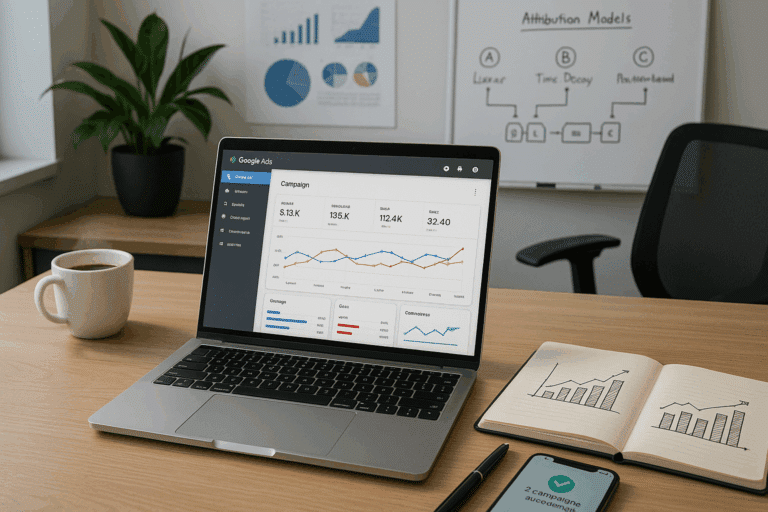Companies large and small are investing heavily in this realm, trying to carve a niche for themselves. But how do you measure the real impact and get the best bang for your buck? 🧐 The answer, my dear reader, lies in “Attribution.”
But what exactly is Attribution? And how can it play a pivotal role in maximizing your return on investment (ROI) in Influencer Marketing Campaigns? This article will delve into the intricate details of Attribution, helping you unlock its full potential. So, sit back, get comfortable, and prepare yourself for a deep dive into the world of Attribution and Influencer Marketing. 💡
Attribution, in the context of marketing, is the process of identifying a set of actions across various touchpoints that contribute in some manner to a desired outcome, and then assigning value to each of these touchpoints. In simpler terms, it’s about figuring out what marketing efforts are working, which aren’t, and why. But when it comes to Influencer Marketing, this task becomes exponentially more complex. How do you effectively track the journey of a user who encountered your brand through an influencer, interacted with your content, and eventually made a purchase? 🕵️♂️
Now you might be thinking, “Okay, Attribution sounds useful. But how can it maximize my ROI?” It’s a valid question and one that we’ll answer comprehensively in this article. By understanding the customer journey, you can optimize your Influencer Marketing campaigns and significantly improve your ROI. 🚀
Throughout the article, we’ll focus on three main topics:
1. The Importance of Attribution in Influencer Marketing
While it’s tempting to credit the last interaction before a conversion (also known as Last-Click Attribution), this approach can oversimplify the customer journey and fail to acknowledge the value of influencer marketing. We’ll explore why Attribution is key to understanding your marketing efforts’ true impact.
2. The Different Types of Attribution Models
Not all Attribution models are created equal. Each has its strengths and weaknesses, and it’s essential to choose one that aligns with your business goals. From Single-Touch Attribution to Data-Driven Attribution, we’ll demystify these models for you. 🧩
3. How to Maximize ROI with the Right Attribution Strategy
Using Attribution to maximize ROI is no small feat. It requires a well-planned strategy, rigorous testing, and ongoing optimization. We’ll walk you through how to leverage Attribution to its fullest potential, maximizing the ROI of your Influencer Marketing campaigns. 💰
Whether you’re new to the world of Influencer Marketing or a seasoned pro, this article will provide valuable insights that can enhance your understanding of Attribution and its role in maximizing ROI. So, strap yourself in for an exciting exploration of Attribution in Influencer Marketing. 🌐
By the end of this read, you’ll be well-equipped to unleash the power of Attribution, turn insights into action, and see your Influencer Marketing Campaigns thrive like never before. Let the journey begin! 🚀
Unleashing the Attribution Power: How to Amplify ROI in Influencer Marketing Campaigns
Unlocking the power of attribution in influencer marketing is the key to maximizing your Return on Investment (ROI). It allows you to understand the impact of your marketing activities and make informed decisions to optimize your strategy. This article will delve deep into the world of attribution, detailing its significance, techniques, and how to utilize it effectively in influencer marketing campaigns.
Understanding the Importance of Attribution in Influencer Marketing
Attribution is a crucial aspect of any marketing strategy. It helps marketers trace the customer journey, determining the touchpoints that led to a conversion. This understanding is invaluable in influencer marketing, where the path to conversion is often nonlinear and involves multiple interactions with different influencers.
Without a robust attribution model, you might undervalue the contribution of influencer marketing to your overall marketing success. This could lead to underinvestment in influencer marketing, leaving potential ROI on the table.
Moreover, attribution can identify the influencers driving the most value for your brand. This can guide investment decisions, enabling you to allocate your marketing budget more effectively.
The Different Types of Attribution Models
There are several attribution models to consider in influencer marketing. Each model assigns credit to touchpoints differently, and the choice of model should align with your marketing objectives.
Here are the three main types:
- First Touch Attribution: This model assigns all the credit to the first interaction that led the user to your brand. It’s useful when your goal is to raise brand awareness.
- Last Touch Attribution: In this model, the last touchpoint before conversion gets all the credit. This model is suitable when your focus is on conversion.
- Multi-Touch Attribution: This model assigns credit to multiple touchpoints along the customer journey. It offers a more holistic view of your influencer marketing effectiveness.
Choosing the right model is vital to accurately measure your influencer marketing ROI.
Maximizing ROI through Effective Attribution
Understanding the importance of attribution and the different models is just the beginning. The real challenge lies in implementing these concepts effectively to maximize your influencer marketing ROI.
Let’s delve into some strategies that can help you achieve this.
1. Identify Key Performance Indicators (KPIs)
Start by defining clear KPIs for your influencer marketing campaign. These could include metrics such as website traffic, engagement rate, or conversions. Having clear KPIs will allow you to measure the success of your campaign and determine the effectiveness of each influencer.
2. Use the Right Tools
Utilizing the right tools can simplify the attribution process. Several marketing platforms offer built-in attribution tracking, allowing you to easily see the impact of each influencer on your campaign. These tools can also provide insights into the customer journey, helping you understand the path to conversion.
3. Analyze and Optimize
Analyze your results regularly to identify the influencers and strategies driving the most value. Use this information to optimize your campaign, investing more in high-performing influencers and revising strategies that are not delivering the expected results.
Boosting your Influencer Marketing ROI: A Case Study
To illustrate the power of attribution in maximizing ROI, let’s look at a case study.
A leading fashion brand launched an influencer marketing campaign to boost its new product sales. They used a multi-touch attribution model, tracking each touchpoint along the customer journey.
By analyzing the data, they were able to identify the influencers driving the most conversions and invested more in collaborations with them. The brand also discovered that customers were more likely to convert after interacting with several influencers, prompting them to invest in collaborations with multiple influencers.
This strategic use of attribution led to a significant increase in their campaign ROI.
Key Takeaways
Unlocking the power of attribution is pivotal in maximizing your influencer marketing ROI. It allows you to track the customer journey, identify high-performing influencers, and make data-driven decisions to optimize your campaign. Understanding the importance of attribution and implementing it effectively can significantly boost your marketing success.
For a more visual understanding of this process, watch this informative video: “Maximizing ROI in Influencer Marketing Through Attribution” by Influencer Marketing Hub.
Now, it’s your turn!
Are you ready to unlock the power of attribution and maximize your influencer marketing ROI? Start by choosing the right attribution model for your campaign, define clear KPIs, and use the right tools for tracking. Regularly analyze your results and optimize your strategy based on data-driven insights.
Remember, the key to successful influencer marketing lies in understanding the customer journey and making informed decisions to optimize your campaign.
So go ahead and unleash the power of attribution in your influencer marketing strategy!

Conclusion
In conclusion, this comprehensive article has sought to simplify and clarify the complex and often misinterpreted concepts surrounding IT and engineering, in line with my main skill of demystifying the technical world. By now, we have covered a vast range of points, diving into the nuanced world of software engineering, discussing the value of technical writing, and explaining the importance of structuring articles effectively. Hopefully, these points have been beneficial to both those starting out in the industry and seasoned professionals alike.
To recap, the article began by addressing the essence of software engineering, a field that integrates mathematics, science and principles of engineering to design, develop, and test software applications. A thorough understanding of this field is crucial, considering the world’s increasing reliance on software systems. From there, we segued into the role of technical writing, a critical yet often overlooked aspect of the industry. Technical writers, such as myself, aim to make these complex concepts more accessible, with their work playing a significant role in bridging the gap between technical experts and the layman.
The importance of structuring articles for a specialized audience was another key point we addressed. Detailed, well-organized content can be a goldmine of information for readers looking to expand their knowledge. However, it’s important to balance depth with accessibility, ensuring readers aren’t overwhelmed.
Embracing these concepts doesn’t only benefit those working within the IT and engineering sectors. In our digital age, almost every industry intersects with technology at some level. Therefore, understanding these ideas can be a great asset for anyone, irrespective of their field of work.
As we conclude, it’s important to remember the critical role technology plays in our lives. From smartphones to complex software applications, technology shapes our world, and those with a clear understanding of its intricacies are those who will succeed in the future.
I encourage you to reflect on what you’ve learned from this article and apply it in your field. Whether you’re an aspiring software engineer, a budding technical writer, or a professional looking to expand your technical know-how, there’s something here for you.
So, don’t hesitate to dive deeper into these topics, share your thoughts, and engage in discussions. Each comment or shared link contributes to a broader understanding of these complex fields. Feel free to share this article within your network, and let’s continue the conversation.
In this digital era, the power of knowledge is just a click away. I hope that this article has served as a catalyst for your learning journey. Remember, as Albert Einstein once said, “The more I learn, the more I realize how much I don’t know.” 🧠💡
Thank you for reading, and I look forward to sharing more insights with you in the future.
Don’t forget to share your thoughts, comments, and questions below. 👇
Your input enriches the conversation and helps us all learn more. Let’s make the most of this opportunity to engage and grow together. 💬🚀
Until next time, keep learning, stay curious, and never stop exploring. 🌐🔍
Sources:
U.S Bureau of Labor Statistics,
IEEE Computer Society



